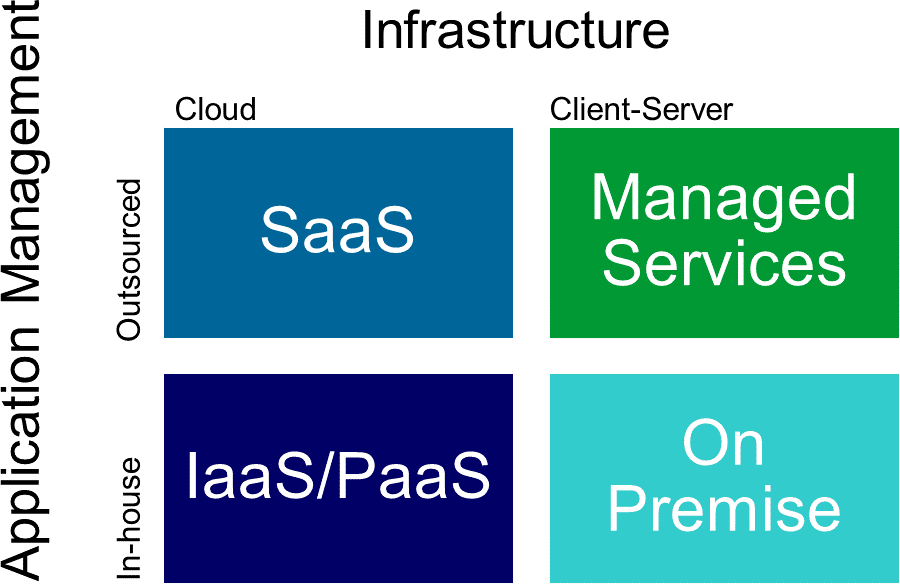Choosing the type of software infrastructure that you want any enterprise software system to run on is an important early step. From cloud to in-house, there are a range of trade-offs between risk, cost and service constraints that you make with each type of infrastructure.
Technology vendors are much in love with revolution and so this next statement will be controversial. From a business manager’s perspective, Software as a Service (SaaS) is fundamentally the same as managed services that have been around for decades.
When you get down it, both application management models mean that it’s someone else’s job to make sure the technology runs smoothly and fix things when problems arise. Then, as now, the reasons a business owner might choose to do this have varied, but probably the best reason for this decision is the recognition that managing IT is not a core requirement of the business and it makes sense to focus the team on what’s important, and let some other professionals take on the IT requirements.
The differences arise when you look at the underlying technology and the options that you have. And it is worth spending a little time to understand the various software infrastructure models.
Cloud Models: SaaS, PaaS, IaaS
The first, and important, consideration is that there are lots of business models that make sense, and that a business can evolve between these models easily as their needs change. Decisions made in these solutions are relatively easy to “unmake” as the business grows, or changes focus.
When people talk about cloud computing, they are talking about distributing computing across a network of commodity computers that share resources in a way that embraces failure.
Clouds are typically built on inexpensive computers and the cloud is programmed so the system can lose some computers without breaking.
If you’re wondering why your company can’t replace your expensive, nuclear-shielded servers with cheap computers in the cloud, then you are asking the right question. There’s no reason you can’t build your own cloud. Just start looking at private cloud vendors.
Software as a Service, Platform as a Service (PaaS) and Infrastructure as a Service (Iaas) are simply different models for building on top of this infrastructure.
SaaS is software built on top of cloud infrastructure. Any software that you access from a browser on cloud infrastructure is SaaS. If you use Gmail or Outlook Online, then you are using SaaS.
IaaS is just the cloud infrastructure. You install or build your own software on IaaS. You could install SYSPRO on IaaS infrastructure and have a cloud-based SYSPRO infrastructure.
Finally, PaaS lies between SaaS and IaaS giving you tools to make building your own applications easier. Typically, when you see SYSPRO in the cloud, it is on Microsoft’s PaaS Azure platform which provides a number of tools for communicating between different SYSPRO programs and non-SYSPRO programs that would take a lot of time to replicate in an IaaS setting.
Differences between SaaS, IaaS, PaaS, and Managed Services
Now that you know everything a manager needs to know about the cloud, let’s get back on track and figure out how these infrastructure models differ.
You can break your application deployment models in to application management (in-house or outsourced) and infrastructure (cloud or client-server) to understand the differences between models and why managed services and SaaS are so similar.

SaaS and managed services both outsource the application management. The difference is that SaaS is built on cloud infrastructure that embraces failure while managed services is built on servers that are designed to avoid failure at all costs.
The application in on-premise, IaaS, and PaaS software is managed in house. You can expect support from the vendor, but if something goes wrong the vendor isn’t going to get up and fix the problem for you without you calling first.
Choosing the Right Infrastructure
Both outsourced application management models will have almost no impact on your IT staff. In fact, if all you run are SaaS and managed services, you probably won’t need IT at all.
If you prefer to be in control of your data and security, or if you have limited Internet connectivity, then on premise is the way to go.
In practice, the cloud model has proven itself to be more robust and economical, but with enterprise software like ERP, getting software that meets your needs with minimal customization is a much more expensive and time-consuming problem than where the software is installed. We’ve seen environments for a complete IT swap-out to a hosted solution done in a few days, and that’s a great way to take the IT management burden off your team’s plate while you focus on the hard stuff – getting enterprise systems to work and add value.
It comes down to managing the risk and cost of having an IT-centric organization managing your solution internally versus the cost and service constraints of having someone else do it for me.
There is no one correct answer—it is a unique decision for each business.




